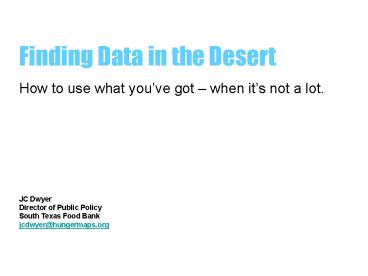Finding Data in the Desert - PowerPoint PPT Presentation
1 / 15
Title: Finding Data in the Desert
1
Finding Data in the Desert How to use what
youve got when its not a lot.
JC Dwyer Director of Public Policy South Texas
Food Bank jcdwyer_at_hungermaps.org
2
NYC
LAREDO
3
NYC
What I Learned
- News is whats new!
- Your data is the best data!
- 3. Keep your eyes on the prize!
4
What I Learned
- News is whats new!
- Your data is the best data!
- 3. Keep your eyes on the prize!
- If your audience is seeing data for the first
time, its new. - If your audience is seeing old data in a new way,
its new. - If your audience is seeing two kinds of old data
together for the first time, its new.
5
What I Learned
- News is whats new!
- Your data is the best data!
- 3. Keep your eyes on the prize!
- Be confident in the data you have (its the best
out there). - Become an authority receiving phone calls, not
just making them. - Be open about your sources share raw data
whenever possible.
6
What I Learned
- News is whats new!
- Your data is the best data!
- 3. Keep your eyes on the prize!
- The report is not the goal and neither is the
coverage. - Get over your inner wonk this is not a
dissertation. - Major decisions are routinely made with far, far
less data.
7
LAREDO
8
What have I got?
LAREDO
- Four kinds of data
- Federal
- State
- Local
- Emergent
9
What have I got?
- Four kinds of data
- Federal
- State
- Local
- Emergent
- You can talk about different datasets just
dont compare them directly. - ACS is great if you can get it CPS is likely
not statistically significant Census 2000 a good
fallback (just do something new with it). - Explore Census.gov for other newsworthy datasets
(like County Business Patterns)
10
What have I got?
- Four kinds of data
- Federal
- State
- Local
- Emergent
- Food Stamps caseloads (families, kids, seniors)
- Food Stamps timeliness rates
- of food stamps recipients who are working.
- Average length of time on program.
- Caveat Sometimes these are only available
regionally.
11
What have I got?
- Four kinds of data
- Federal
- State
- Local
- Emergent
- WIC caseloads (usually regional)
- WIC health stats
- School meals ( free reduced, breakfast
participation) - After-school snacks
- Summer meals
- Head Start
- A2H 2005 study get raw data and you can select
by zip code
12
What have I got?
- Emergent data is a new economy term for data
that you have but dont know it yet. - Typically used to increase internal efficiency
- Examples Monthly agency reports, Kids Café
numbers, agency longevity, CSFP waiting lists
any big number can be a newsworthy number. - Think about untraditional numbers poundage,
truck miles, square feet etc.
- Four kinds of data
- Federal
- State
- Local
- Emergent
13
How to Design Your Data
- Structure
- Physically break your report into counties
design so that each county section looks the
same. - If report covers several counties, make sure you
have one or two datasets that cover everyone to
justify using the rest of the data. - Include a short summary with take-away message
and a couple of the most newsworthy stats in the
front. - Keep all notes, explanations, errata in the back.
14
How to Design Your Data
- Text
- GET OVER YOUR INNER WONK.
- Simple short sentences gt tables gt long,
interminable sentences - Repeat your take-away with each countys data.
- Stack your data on each page in a way that makes
narrative sense (problem statement, details,
solutions) - Use lots of visual metaphors pitched to the local
audience (sports arenas work well)
15
How to Design Your Data
- Visuals
- Charts, graphs trend lines work best.
- If you have a flair with Photoshop, illustrate
some of your textual metaphors - Pulled quotes, supporting quotations add
highlights - Use good design sense only 2-3 fonts, dont
overuse bold, italics, underline, font size. Be
consistent. - Use GIS HungerMaps.org































